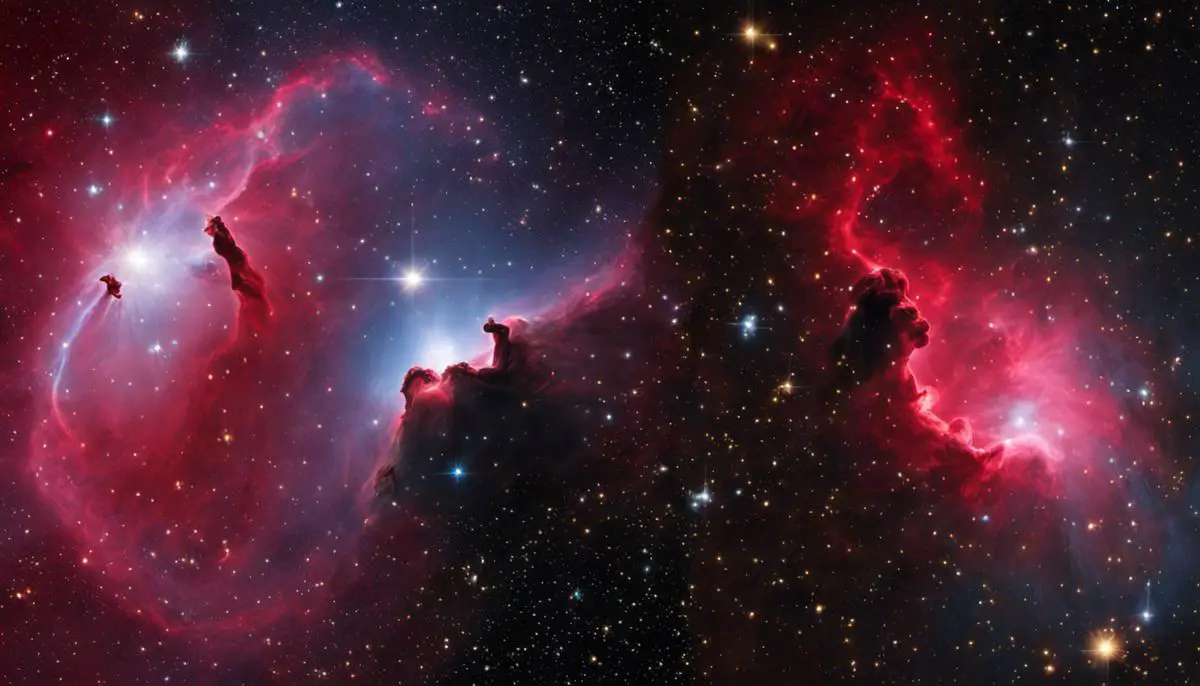One of the most distinctive celestial bodies in our universe is the iconic Horsehead Nebula. Nestled in the vast constellation of Orion, this nebula holds a captivating allure for both stargazers and astrophysicists alike. Its discovery unveiled a new chapter in our understanding of cosmic bodies and their lifecycle. The nebula’s majestic structure, composed from a blazing cocktail of dust, gases, and star particles, lends it a unique ‘horsehead’ appearance that has left an indelible mark not only on science but also on art, literature, and popular media. In this essay, we journey to this distant nebula to explore its genesis, delving into its physical attributes, its role in star creation, and the scientific milestones achieved in its study.
Origin of Horsehead Nebula
Origin and Discovery
The Horsehead Nebula, also known as Barnard 33, is a fascinating astronomical object discovered by Scottish astronomer, Williamina Fleming, in 1888 at the Harvard College Observatory. Located in the constellation Orion, the nebula is positioned south of Alnitak, the easternmost star of Orion’s Belt, and is approximately 1,500 light-years away from Earth. The Horsehead Nebula’s well-known equine resemblance rises out of a dense cloud of gas and dust, giving it its iconic and descriptive name.
In-Depth Examination
Scientific observation of the Horsehead Nebula begun in the late 19th century and since then has been captured in several series of images provided by iconic observatories such as the Hubble Space Telescope. These initial studies allowed for the detailed charting of the nebula’s observable features and played a substantial role in better understanding the behavior of nebulae in general.
Constituents and Features
The Horsehead Nebula is a part of the larger Orion Complex, which includes other nebulae created by high-mass stars. The unique shape of the Horsehead Nebula is due to a dense dark dust and non-luminous gas being lit from behind by a bright emission nebula known as IC 434. This entire region is a hub of ongoing star formation, characterized by the abundant presence of dark dust that makes it a perfect breeding ground for young stars. The dust functions as a nursery of sorts, providing the necessary elements for stellar births.
Role in Astrophysics
The Horsehead Nebula plays a pivotal role in the field of astrophysics as it is an excellent example of a dark nebula. Dark nebulae are interstellar clouds so dense with cosmic dust that they obstruct visible light passing through them. Scientists study dark nebulae like the Horsehead to understand the birth and life cycles of stars, as these ‘stellar nurseries’ drive the evolution of galaxies. By observing and analyzing the physical and chemical processes within these nebulae, astrophysicists are able to deduce how gas and dust can coalesce to kickstart the process of star formation.
Recent Research
Significant scientific interest has been generated by the distinctive Horsehead Nebula due to its unique characteristics. Highly revealing infrared images of the nebula were captured by the Hubble Space Telescope in 2013, significantly expanding our understanding of its inner composition. These photographs highlighted an intricate structure, including specifics like streamers of gas being eroded from the nebula by the radiation pressure from Sigma Orionis, a star in close proximity. Ongoing research continues to enhance our comprehension of the intricate processes occurring within these colossal cosmic cloud structures.
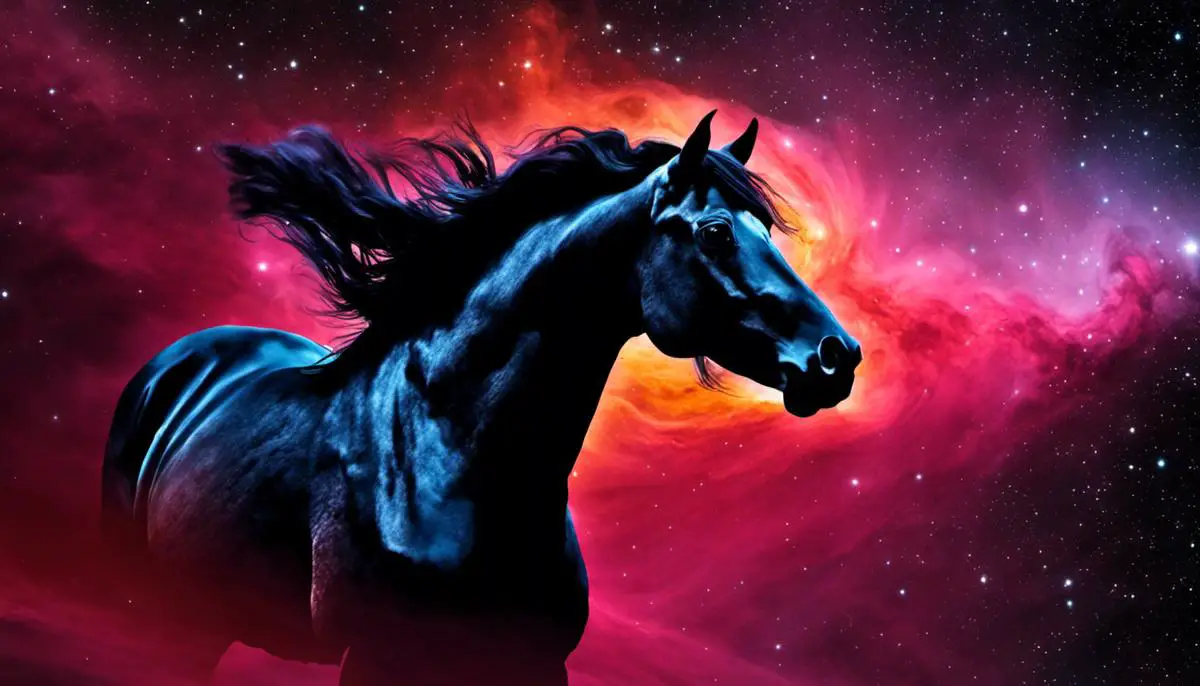
Physical Structure of Horsehead Nebula
Physical Characteristics of the Horsehead Nebula
Recent astrological research reveals that the Horsehead Nebula, aptly named due to its unique “horse head” shape, is an astronomical wonder. Residing a considerable distance from Earth, approximately 1500 light-years away, it is part of the greater Orion Molecular Cloud Complex and spans an impressive four light-years from end to end. The nebula’s overall vertical stretch is about 5 light-years, underscoring its remarkable grandeur.
The Horsehead Nebula serves as a quintessential example of a dark nebula. Its dense accumulation of cosmic dust and gases creates a dark effect that obscures the light radiated by the stars behind it, primarily contributing to the nebula’s distinctive silhouette. It’s this stark contrast against a backdrop of brightly lit gases that give the Horsehead Nebula its well-recognized composition.
Unique ‘Horsehead’ Shape and Formation
The nebula’s shape is a direct consequence of both stellar wind and radiation. It’s formed by a dense cloud of gas and dust, which is resistant to the ultraviolet radiation emitted by the nearby massive star Sigma Orionis. The radiation burns away the material and forms the clear cut, well-defined shape that resembles a horse’s head when viewed from Earth.
The most recent data from research indicates this nebula, specifically the Horsehead region, has a dense gathering of molecular hydrogen gas and dust, which are the primary building blocks of star formation. The swirling mix of gas and dust is turbulent, and areas within the cloud may collapse under their gravitational pull, forming new stars.
The Texture of the Horsehead Nebula
The Horsehead Nebula has varied textures that come from its different constituents. The mix of dust and gases like hydrogen, helium, and trace numbers of other elements give the nebula its distinct look. Dust particles, made up of silicates, water ice, and carbonaceous compounds, block visible light and appear dark. This dust creates a stark silhouette in front of the glowing hydrogen gas, ionized and lit up by the bright star Sigma Orionis.
Delving into the Mysteries of the Horsehead Nebula
The renowned Horsehead Nebula serves as an exceptional tableau for scientists to observe and understand the star formation process at play throughout the universe. In addition to its significance as a research site, the nebula’s distinctive shape has made it a highly sought after subject for astronomical study and a cherished sight for astrophotography enthusiasts. Dense filaments of gas and dust within the nebula are key resources for the creation of new stars, and their presence contributes to the intricate dynamics and chemical changes occurring within the nebula, amplifying its importance in astronomical research.
The distinctive structure and composition of the Horsehead Nebula offer a compelling focus for scientific inquiry. The nebula manifests the mechanics of star creation while also elucidating the impact of stellar wind and radiation in celestial spaces. The Horsehead Nebula, therefore, is a crux contributing to our evolving understanding of the universe.
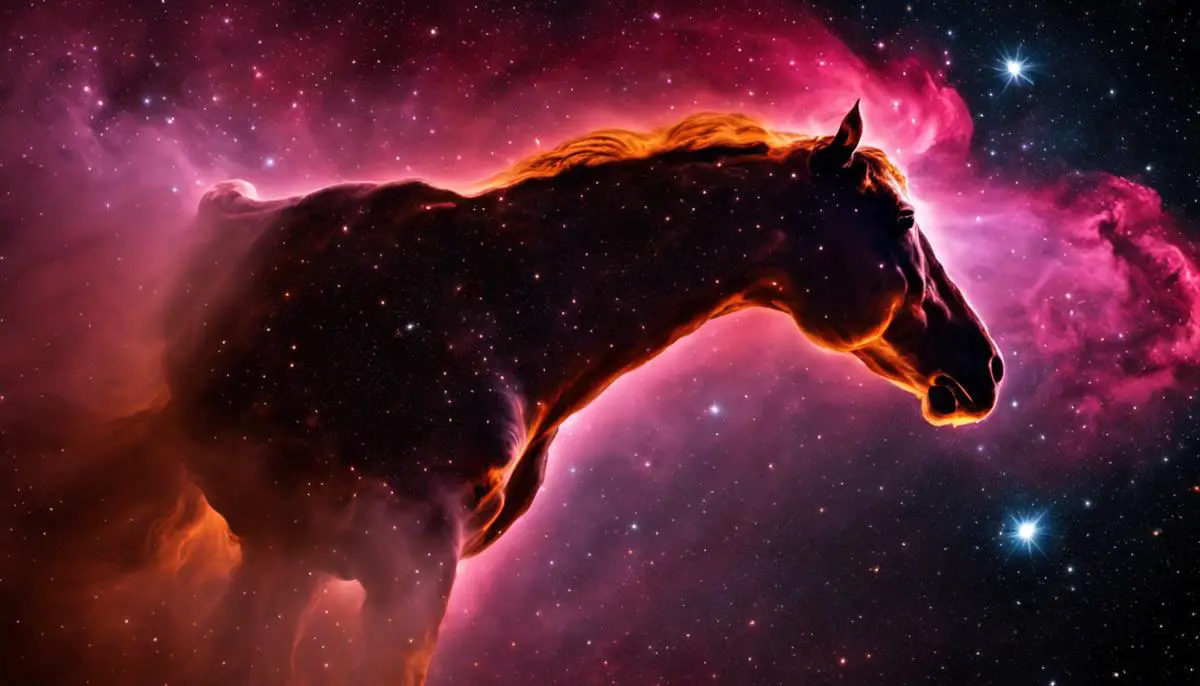
Creation and Life Cycle of Stars in Horsehead Nebula
Birth of Stars within the Horsehead Nebula
Aside from its striking shape and vibrant colors, the Horsehead Nebula harbors a distinctly fascinating element – the continuous cycle of star birth. Acting as a ‘cosmic maternity ward’, the nebula’s interior conditions, abundant with substantial amounts of dust and gas, are ideal for star formation, a process indispensable to galactic evolution.
In detail, the nebula’s heavy gas and dust components are gravitationally drawn inward, leading to the creation of a compact core, also known as a molecular cloud. As this dense core grows in mass, the consequent rise in internal pressure and temperature leads to the initiation of nuclear fusion. This process results in the birth of a protostar, marking the inception of a new star’s life cycle.
Evolutionary Stages of Stars in the Horsehead Nebula
The life of a star can be divided into several key stages. After its birth as a protostar, the star continues to grow by accumulating cooler gas and dust from its surrounding environment. This stage is termed the ‘T-Tauri’ stage.
Following this evolutionary phase, the star moves to the ‘Main Sequence’ stage. It is here that the star starts to shine brightly due to nuclear reactions at its core. The star will remain in this phase for most of its life — a period that can last from a few million to several billion years, depending on its initial mass.
Large stars burn their fuel rapidly and become red giants, whereas smaller stars — like our sun — expand more slowly and become red dwarfs. After this expansion phase, the star’s remaining material is expelled, often creating beautiful and intricate planetary nebulae.
For high-mass stars, the next stages involve a supernova explosion, leaving behind a neutron star or black hole. Lower-mass stars like our Sun will eventually dissolve their outer layers, leaving behind a white dwarf, which cools over eons.
Horsehead Nebula: A Celestial Star Factory
Located at a relatively close distance to our planet, the Horsehead Nebula stands as an incredible site for scientific exploration, mainly due to the active process of star formation taking place within it. This nebula not only offers researchers a window into the diverse evolutionary stages of star development, but also offers remarkable opportunities to unravel the mysteries driving the life cycle of stars.
Crucial to note is the cycle of stellar creation and extinction present in the Horsehead Nebula that enriches its surrounding environment, recycling essential star-forming ingredients for new celestial generations. This continuous cycle – marked by creation, destruction, and renewal – is like the cosmic heartbeat, underlining the nebula’s vitality.
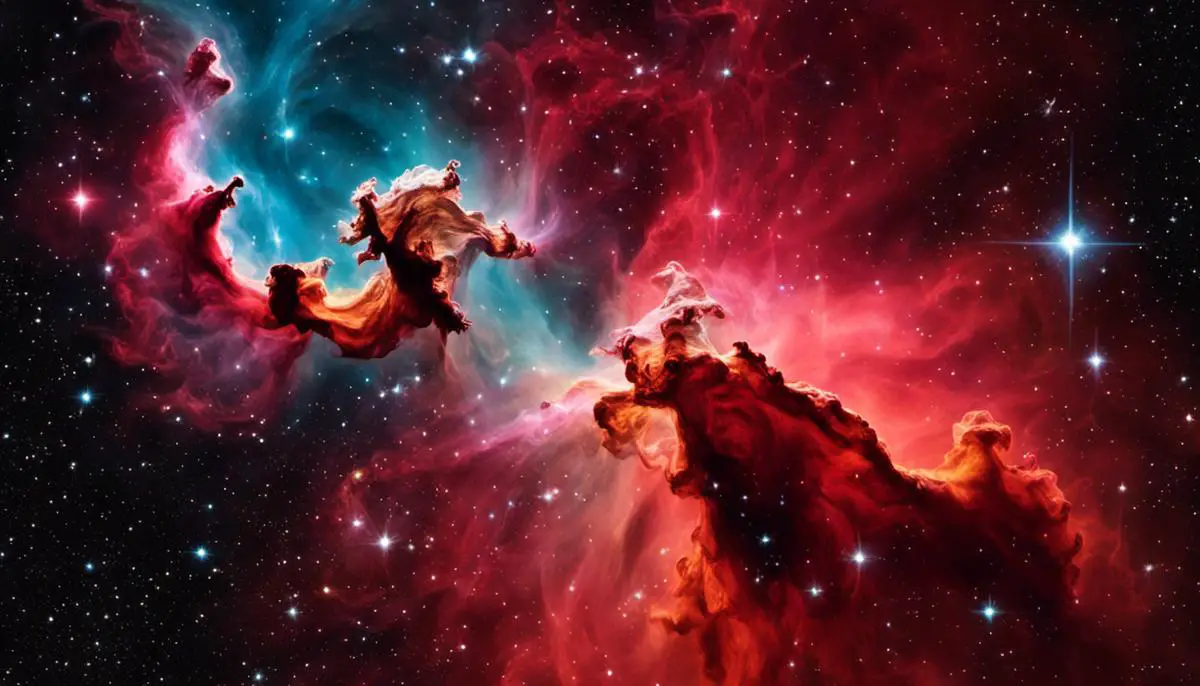
Scientific Studies and Researches Conducted on Horsehead Nebula
Insights from the Hubble Space Telescope’s Study of the Horsehead Nebula
One of the most comprehensive investigations into the Horsehead Nebula has been facilitated by the Hubble Space Telescope. Nestled within the constellation Orion, and situated roughly 1,500 light-years away, the Horsehead Nebula is a cosmic cradle where new stars are being ceaselessly formed from a rich blend of gas and dust. Astronomers show a special interest in the complex structures within the nebula, including interstellar clouds, shock waves, and the impressive pillars housing the raw materials instrumental for star formation.
Infrared Imaging of Horsehead Nebula
Hubble’s high-resolution optical cameras allowed astronomers to capture stunning images of the Horsehead Nebula, but another crucial step forward was the use of infrared imaging. By observing in the infrared, astronomers can see through the dust that obscures much of the nebula in visible light. This has been fundamental in revealing the complexities of its star-forming processes. Scientists have noticed that as the dense gas collapses under its gravity, clumps start forming which then leads to star births.
Key Findings and Discoveries
One significant finding is that the Horsehead Nebula is a remarkably stable structure. Despite the vigorous processes occurring within it, the nebula retains its singular shape. Scientists have concluded that strong magnetic fields within the nebula resist the gravitational forces, keeping the horse’s head formation intact.
Another vital discovery has been about the nebula’s rate of star formation. Traditionally, it was thought that star-forming regions in the universe were highly active, with hundreds of stars being born or dying at any given moment. However, studies on the Horsehead Nebula have revealed that it operates at a much slower pace, with an average star formation rate roughly equivalent to one Sun-like star every 10,000 years.
Recent Discoveries and Investigations
Space scientists use cutting-edge technology to explore celestial phenomena, like the Horsehead Nebula. For instance, the European Space Agency’s Herschel Space Observatory has penetrated into the nebula’s icy, dust-laden clouds, probing far-infrared and submillimeter wavelengths. This access helped researchers gain invaluable insights into the nebula’s internal workings.
Moreover, ground-based telescopes, such as the Atacama Large Millimeter/submillimeter Array (ALMA), offer further explorative opportunities. With its unique capacity to peer through gas and dust, ALMA has hinted at planetary formation around stars within the nebula, which might have otherwise concealed behind dense clouds. These recent initiatives have enormously enriched our knowledge about the Horsehead Nebula and elevated our comprehension of the cosmos.
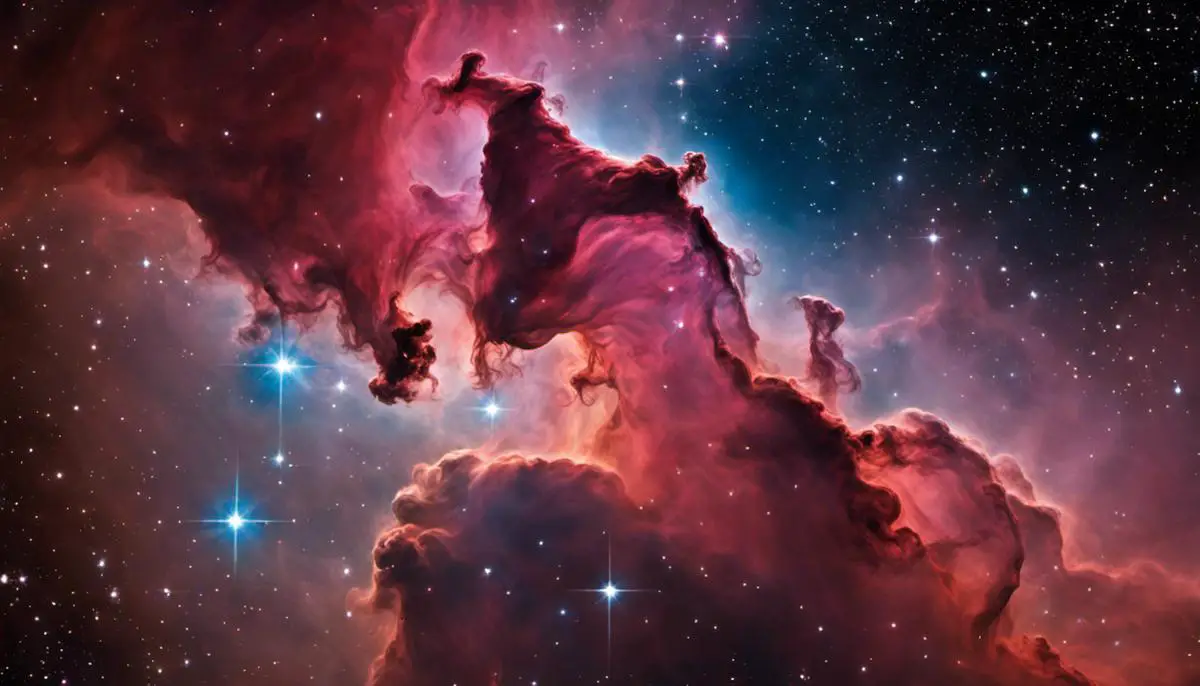
Aesthetic Aspect and Public Influence of Horsehead Nebula
The Visual Appeal of the Horsehead Nebula
As one of the most stunning locales in the cosmos, the Horsehead Nebula, technically referred to as Barnard 33, is a massive cloud of ionized gases, dust, and helium. The cause of its unique attraction lies in its striking shape, reminiscent of a horse’s head, hence the name. This discernible and vivid depiction rouses the interest of both scientific and non-scientific audiences alike, unlike other nebulae showcasing more abstract imagery.
The ample cosmic dust in the Horsehead Nebula is responsible for shaping its iconic dark outline against the backdrop of luminous gases. Moreover, the dramatic clash of red and black hues results from the nebula’s position within a larger complex, known as IC 434. This dazzling backdrop accentuates the beauty of the nebula, turning it into a visually enticing celestial spectacle.
Horsehead Nebula in Popular Culture
The Horsehead Nebula’s iconic shape and natural beauty have inspired various creative expressions in art, literature, and media. It is frequently used as a visual element in space-themed artwork, astronomical illustrations, and as backgrounds in modern digital design. It is an emblem in the field of astrophotography, providing stunning images that are circulated worldwide in print and digital media.
In literature, the Horsehead Nebula forms the backdrop for many science fiction narratives where interstellar travel is a central theme. Its distinct, stimulating mental images add depth and intrigue to the storyline. On screen – from television to Hollywood – the Horsehead Nebula is a favorite among creators for conveying the vast and mysterious aspects of the universe.
Interpreting Horsehead Nebula’s Influence on Understanding of Space
The Horsehead Nebula’s visibility and aesthetic appeal play a crucial role in engaging the layperson’s interest in understanding space and the universe. It serves as an embodiment of the cosmic beauty and grandeur that lies beyond Earth’s boundaries, igniting curiosity and promoting explorative interest.
Moreover, as the nebula is primarily composed of hydrogen gas and dust where star formation occurs, it aids in comprehending the stellar life cycle. Through observing and studying the nebula, both professional scientists and amateur astronomers can learn as well as educate others about the processes that drive the workings of the universe.
Moreover, the frequent appearances and references to the Horsehead Nebula in popular culture aids in informal learning about the cosmos. It provides a familiar image that helps bridge the gap between scientific research and public understanding, thereby making astrophysical knowledge more accessible to the general public.
Horsehead Nebula’s Influence on Cultural Perspective
The majestic spectacle that is the Horsehead Nebula has also affected cultural perspectives on existence, life, and the mysteries of the universe. Its observable beauty and imposing scale often lead to reflections on our place in the universe, promoting philosophical and existential discussions.
Cultures across the world, impressed by the awe-inspiring visuals of the nebula, have also integrated it into their spiritual and religious narratives, symbolizing themes like creation, infinity, and divinity. In effect, the Horsehead Nebula’s influence extends beyond scientific understanding, permeating assorted facets of human thought and culture.
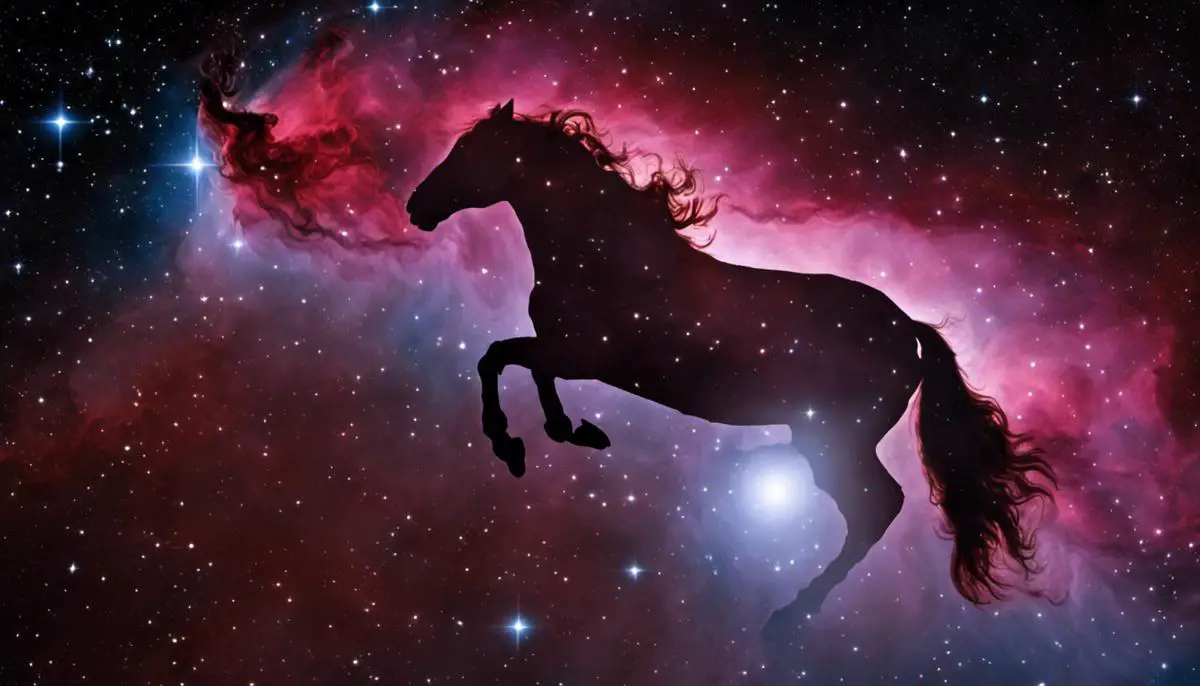
After this enriching voyage to the Horsehead Nebula, we find ourselves imbued with a deeper respect for the boundless complexity of our universe. The nebula, with its distinctive shape and significant scientific contribution, serves as a compelling gateway for the general public to delve into the wonders of astronomy. Its influence permeates societal dimensions, manifesting in various expressions of art and literature, and thereby reinforces the interconnectedness of scientific discovery and cultural interpretation. As we continue to explore and understand these celestial bodies, we enrich our perspective of the cosmos and our place within it. The Horsehead Nebula, after all, is more than just a silhouette against the cosmic canvas; it is a testament to the marvel of constellations, a cradle for stars, and a source of human fascination spanning centuries.
![]()
